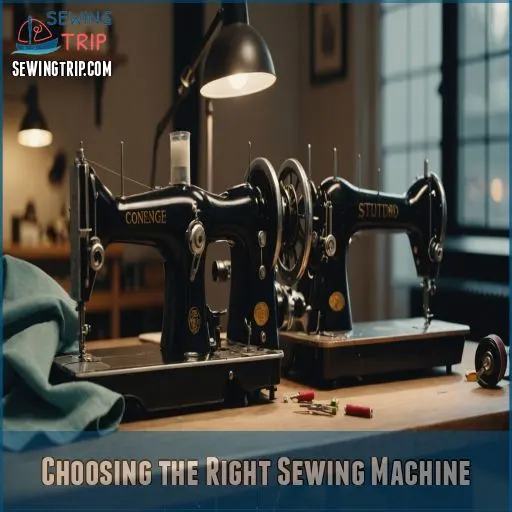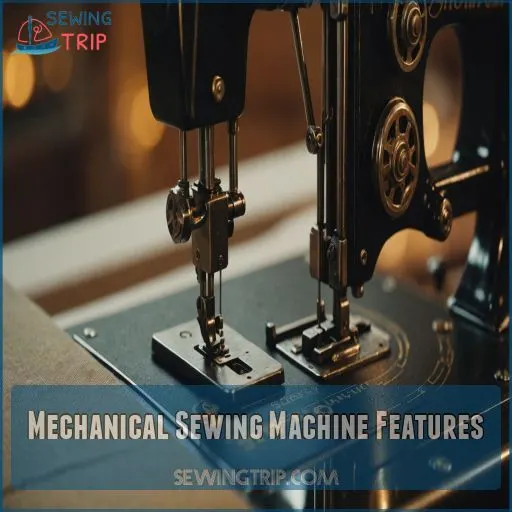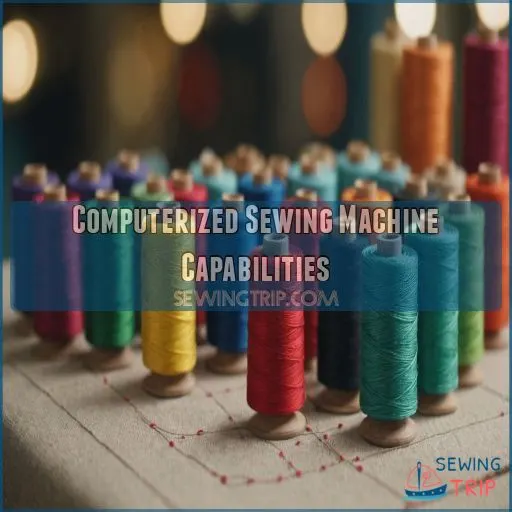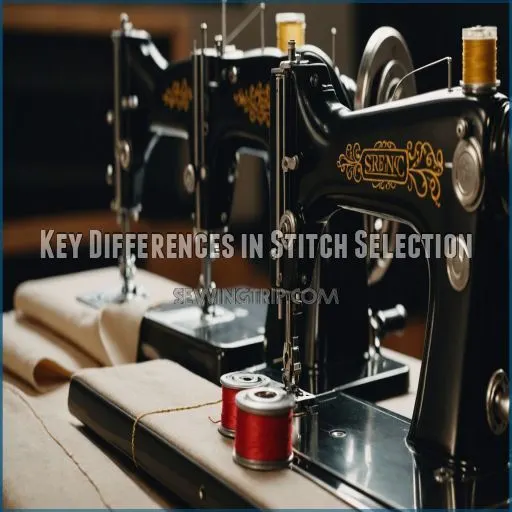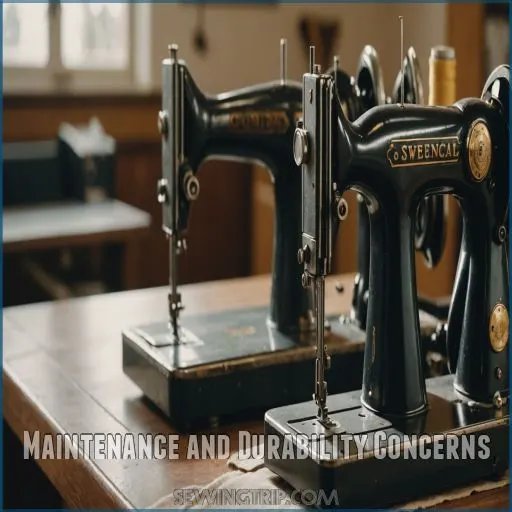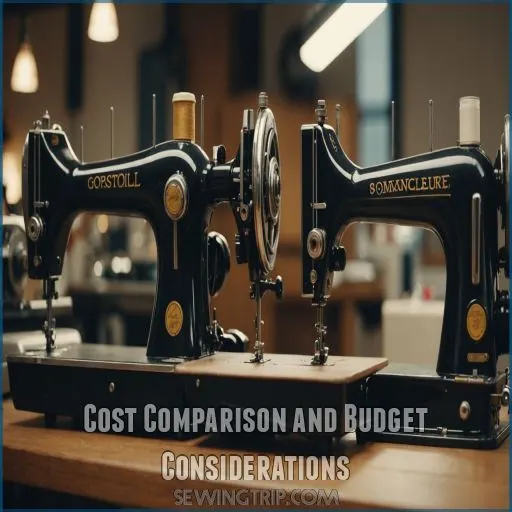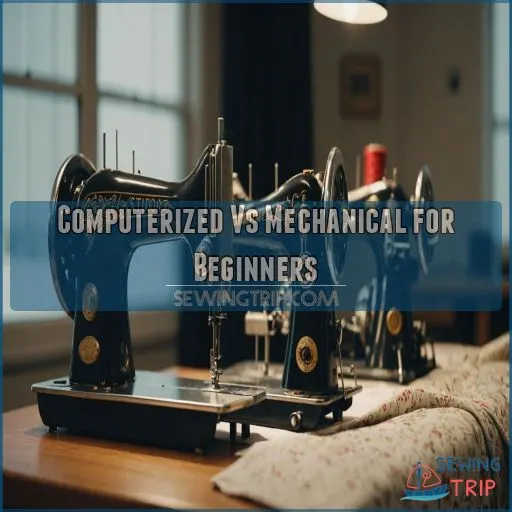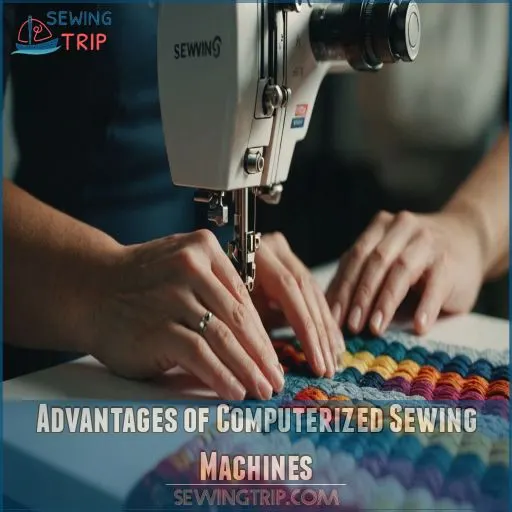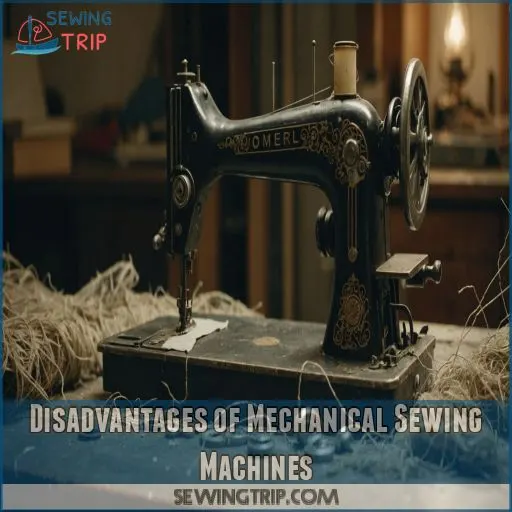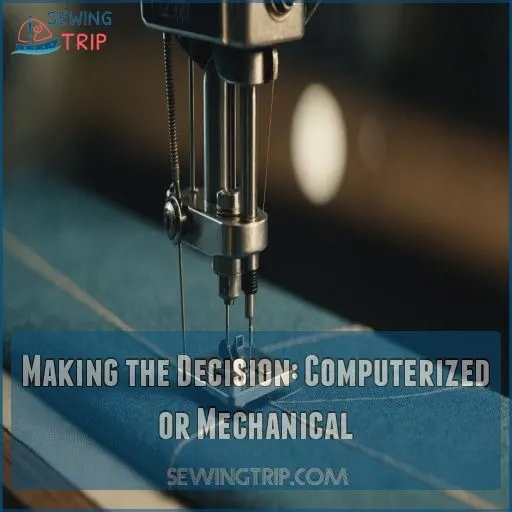This site is supported by our readers. We may earn a commission, at no cost to you, if you purchase through links.
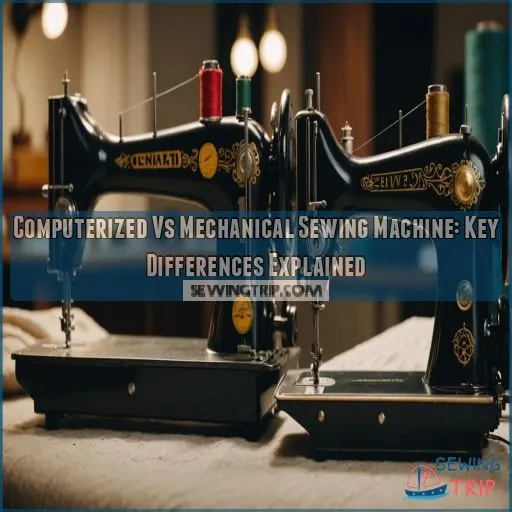
Computerized machines, on the other hand, are the Swiss Army knives of stitching. They’re packed with fancy features, boasting hundreds of stitch options and automated functions. But don’t let that scare you off! While they might seem intimidating at first, many beginners find computerized machines surprisingly user-friendly.
The real question is: do you want a reliable workhorse or a high-tech marvel?
Table Of Contents
- Key Takeaways
- Choosing the Right Sewing Machine
- Mechanical Sewing Machine Features
- Computerized Sewing Machine Capabilities
- Key Differences in Stitch Selection
- Maintenance and Durability Concerns
- Cost Comparison and Budget Considerations
- Computerized Vs Mechanical for Beginners
- Advantages of Computerized Sewing Machines
- Disadvantages of Mechanical Sewing Machines
- Making the Decision: Computerized or Mechanical
- Frequently Asked Questions (FAQs)
- Conclusion
Key Takeaways
- You’re choosing between the flip phone and smartphone of sewing — mechanical machines are simple and sturdy workhorses perfect for beginners, while computerized ones are feature-packed marvels that can turn your crafting dreams into reality.
- Your budget and skill level are your sewing compass — mechanical machines are wallet-friendly and easier to learn, but computerized options offer more room to grow (though they might make your piggy bank squeal at first).
- Stitch options are like picking ice cream flavors — mechanical gives you the classics (think vanilla and chocolate), while computerized is the whole ice cream parlor. If you’re happy with the basics, mechanical’s your buddy; if you want to embroider the Mona Lisa, go computerized.
- Maintenance is like caring for a pet — mechanical machines are low-maintenance cats, while computerized ones are high-energy puppies. You’ll spend less time and money keeping a mechanical machine purring, but a computerized one might need more TLC (and potentially pricier vet visits).
Choosing the Right Sewing Machine
Choosing the right sewing machine can feel like you’ve stumbled into a maze of options, but it’s easier when you know your needs and budget.
Whether you’re a newbie or a seasoned stitcher, start by thinking about your projects and checking out reviews—your perfect machine is out there waiting!
Evaluating Your Sewing Needs
When evaluating your sewing needs, imagine the joy of stitching a masterpiece.
Consider how often you sew and the complexity of your projects.
Do you fancy embroidering or working with varied fabrics?
Whether you’re eyeing a computerized sewing machine for stitch variety or a trusty mechanical one for simplicity, make sure it matches your desired features and stitch customization .
Considering Your Budget
Setting a budget for your sewing adventure helps narrow choices between mechanical and computerized machines.
Consider these budget-friendly options that offer value for money without breaking the bank:
- Affordable sewing machines offering fewer stitch patterns but rock-solid durability.
- Cost-effective sewing for the savvy crafter seeking long-term savings.
- Machine applique flexibility gives creative freedom even on a budget.
- Easy learning curve for beginners.
Assessing Your Skill Level
As a beginner, your skill level is the key factor in choosing the right sewing machine.
Don’t be intimidated – even if you’ve never sewn before, there are user-friendly options that will build your confidence.
Consider your comfort with technology and the complexity of projects you plan to tackle.
Researching Different Models
You’ve assessed your skill level; now, let’s explore different models.
Focus on brand reputation and user reviews to narrow choices.
Compare features and price ranges, ensuring options suit your needs.
A decent warranty can save headaches later.
Whether you lean toward a trusty Singer or a versatile Brother (Source), there’s a model that’s just right for you!
Mechanical Sewing Machine Features
If you’re looking for a sewing experience that’s straightforward and budget-friendly, mechanical sewing machines are your go-to companions.
They’re perfect for those who prefer simplicity with their easy controls and durable build, making you feel like a seasoned pro in no time.
Simplicity and Ease of Use
Imagine this: operating a mechanical sewing machine feels like driving an old, trusty car.
It’s beginner-friendly, with intuitive controls that give you a hands-on approach to sewing.
The experience is familiar and straightforward, offering an enjoyable learning curve.
Without the fancy frills of computerized models, you’re in control, mastering the art with every stitch.
Talk about sewing joy!
Basic Stitch Options and Customization
You’ve got simplicity at your fingertips with mechanical sewing machines.
These machines offer stitch types like straight stitch, zigzag, and even some decorative stitches, putting you squarely in the driver’s seat.
Adjust stitch length and width manually; it’s like tuning an old radio.
Buttonholes? Not to worry—they’re in your toolkit, too (Source).
Durability and Long-Term Value
When you think about durability, mechanical sewing machines shine like a trusty steed.
They’ve got fewer electronic parts, which means less frequent repairs and lower maintenance costs.
Their simpler mechanics often mean a longer lifespan, better parts availability, and they tend to hold their resale value well.
These qualities make them solid investments for sewists who prize reliability .
Maintenance and Repair
While focusing on durability, let’s chat about maintenance for mechanical sewing machines.
A regular maintenance schedule keeps them purring like kittens.
DIY repairs often handle common issues like hook timing and tension troubles, saving trips to repair shops.
With some basic troubleshooting, you can solve many problems at home and enjoy the satisfaction of mastery .
Computerized Sewing Machine Capabilities
If you’re looking to take your sewing skills to the next level, computerized sewing machines offer a world of advanced capabilities.
These machines can handle a wide range of sewing projects with ease.
From automated features that boost precision to a vast selection of stitches, these machines can provide various options for your crafting needs.
Advanced Stitch Options and Customization
In contrast to mechanical machines, computerized sewing machines open up a world of stitch customization, letting you tap into a treasure trove of decorative stitches and embroidery designs.
Imagine having a stitch library at your fingertips!
Whether you’re crafting custom stitches or exploring intricate patterns, these machines offer a creative playground that mechanical models simply can’t match .
Automated Features and Precision
Computerized sewing machines offer automated features and precision like you’ve never seen. They’re your sewing partners, helping with:
- Automated Stitch Selection: Pick stitches with a touch.
- Precision for Quilting: Stitch accuracy can be a game-changer.
- Needle Threading Ease: Threading woes? Not anymore.
- Tension Control Impact: Say goodbye to thread tension tantrums.
With these, sewing’s a breeze!
Versatility in Sewing Projects
Getting a sewing machine is like opening Pandora’s box of fabric possibilities!
You’re not just choosing stitches; you’re diving headfirst into a pool of creativity.
Computerized machines make conquering various fabric types a breeze, offering stitch variety ideal for tackling anything from intricate embroidery to cozy quilts, turning every project into an adventurous masterpiece .
Touchscreen Interface and Ease of Use
While versatility is fantastic, a sewing machine’s touchscreen navigation can make user experience smoother.
With responsive, intuitive controls, even beginners won’t feel daunted!
The digital interface simplifies operation—no more guessing games with levers and dials. It’s like having a GPS for sewing; you just tap and sew, minimizing the learning curve. Now, crafting masterpieces has never felt more seamless.
Key Differences in Stitch Selection
When comparing sewing machines, stitch selection is a game-changer.
You might find the mechanical machine’s simplicity comforting,
while the computerized option feels like opening up a whole new world of sewing possibilities with its extensive variety.
Mechanical Vs Computerized Stitch Options
So, you’ve tackled computerized machine capabilities—now let’s stitch together the options. Mechanical machines offer simplicity, with essential choices like straight and zig-zag stitches .
Computerized machines, however, boast a vast stitch variety, serving up patterns galore, like a buffet of creativity .
Sure, it might seem like talking to a robot, but the stitch accuracy is a serious perk!
Customization and Flexibility
With a computerized sewing machine, you’ll enjoy unparalleled customization and design flexibility.
You can easily select from a vast array of built-in stitches,
adjust stitch length and width with the touch of a button, and
even create your own custom stitches for truly unique projects.
The creative control is empowering!
Learning Curve and Ease of Use
Diving into sewing? The learning curve can vary depending on whether you choose mechanical or computerized machines.
Mechanical models, with their beginner-friendly simplicity, offer direct control—a comforting aspect when you’re new to stitch learning.
On the flip side, computerized machines boast an intuitive interface design, though initially overwhelming; training resources and troubleshooting tips can ease the process .
Stitch Quality and Precision
Shifting from ease of use to stitch quality opens a new world of sewing.
Computerized machines often excel with:
- Stitch consistency: Perfect for those oh-so-important seams.
- Seam finishing: Smooth as silk, whether you’re a pro or not.
- Tension control: Keeps those stitches even.
- Puckering issues: Say "goodbye" forever.
- Fabric types: Handles everything from satin to denim like a champ.
Maintenance and Durability Concerns
Choosing between a mechanical and computerized sewing machine can feel like picking between a trusty old bicycle and a sleek new car.
Maintenance and durability are important factors to consider when choosing a sewing machine.
Knowing each type’s quirks and potential repair needs will help you keep your creative engine running smoothly.
Mechanical Machine Maintenance
Stitching success hinges on maintenance.
Regular cleaning and a bit of oiling where your machine manual advises keep gears humming and extend lifespan .
Stay sharp—change needles often to avoid frustrating breaks.
Here’s a quick chart for essential mechanical care:
| Task | Frequency |
|---|---|
| Needle Change | Every 8 hours |
| Cleaning | Monthly |
| Oiling | As needed |
| Troubleshooting | Every issue |
| Repair | When necessary |
Computerized Machine Maintenance
Taking care of a computerized sewing machine isn’t rocket science, but it does need a bit more love than mechanical ones.
Regular cleaning and lubrication keep it running smoothly.
Keep an eye on software updates too—think of it like a digital oil change!
Protect your warranty by following the manual’s instructions for care and maintenance .
Repair and Troubleshooting
How do you tackle common sewing machine issues without calling a technician?
Start by checking the needle—it’s the key player in your sewing game.
A bent one can unravel your plans faster than a cat in a yarn factory .
Try simple DIY repairs and re-thread your machine carefully .
If all else fails, finding a technician could save the day .
Long-Term Value and Cost-Effectiveness
If you’re looking for long-term value, mechanical sewing machines often come out on top.
These workhorses are built to last, requiring minimal maintenance beyond the occasional oiling and cleaning.
With proper care, they can chug along for decades, making them a smart investment that pays off over time.
Computerized models may pack more bells and whistles, but their complex electronics can be pricier to repair.
So if longevity and cost-effectiveness are priorities, a trusty mechanical machine might be your best bet.
Cost Comparison and Budget Considerations
When choosing between computerized and mechanical sewing machines, understanding the cost differences is important.
While mechanical machines are easier on the wallet upfront, computerized models come loaded with features that could make them worth the investment if you’re ready to splurge and expand your sewing adventures!
Initial Investment and Upfront Costs
Sewing machines come in all shapes and sizes, and you’ll find computerized options tend to have higher initial costs compared to their mechanical cousins.
They can sometimes feel like buying a sports car when all you need is a trusty bicycle.
But don’t worry, both offer budget-friendly options if you compare machine prices carefully for value and your specific needs.
Long-Term Value and Cost Savings
Get the most out of your sewing machine by focusing on its maintenance, lifespan, and repair costs.
Consider these tips for cost savings:
- Invest wisely: Choose durable models to maximize lifespan.
- Maintenance matters: Regular care reduces repair costs .
- Accessories: Keep essentials handy, minimizing extra expenses.
- Resale value: Quality machines retain worth.
Sewing smart saves money!
Accessories and Additional Expenses
Accessories can make or break your sewing journey.
Consider this table for essential add-ons:
| Accessory | Cost Range |
|---|---|
| Foot Pedal | $20 – $50 |
| Needle Packs | $5 – $15 |
| Bobbins | $5 – $20 |
| Machine Oil | $5 – $10 |
Invest in quality sewing threads for smooth stitching.
Avoid cheap bobbins; they might jam your rhythm.
Maintenance and Repair Costs
Balancing your budget involves weighing maintenance and repair costs.
DIY repairs can save a fortune, but tech-savvy computerized machines often need professional servicing.
Here’s the scoop:
- Mechanical machines typically need annual tune-ups, costing $50-$100 .
- Computerized models, with intricate parts, may require frequent visits.
- Check warranty coverage and parts availability to manage expenses.
Computerized Vs Mechanical for Beginners
Choosing between a computerized and mechanical sewing machine as a beginner can feel like picking a meal from an endless buffet—exciting yet overwhelming!
Don’t worry, we’ll help you navigate this decision with a comparison guide that breaks down ease of use, nifty features, and budget-friendly options.
Ease of Use and Learning Curve
As a beginner, a mechanical sewing machine may be the way to go.
With its straightforward controls and limited stitch options, you can quickly get the hang of the basics without feeling overwhelmed.
The Emerald 118‘s intuitive dial and independent stitch length/width adjustments make it a breeze to use, even for complete novices.
| Feature | Mechanical | Computerized |
|---|---|---|
| Stitch Selection | Simple dial | Touchscreen menu |
| Stitch Customization | Basic adjustments | Advanced options |
| Learning Curve | Quicker to master | Steeper initial curve |
| Practice Time | Less required | More time needed |
| Machine Interface | Uncomplicated | More complex |
Features and Customization Options
Exploring the features and customization options, you’ll find mechanical sewing machines simple yet effective.
They focus on basic stitch types and ease of use.
On the flip side, computerized machines offer:
- Tons of stitch settings and embroidery patterns
- Various buttonhole styles
- Automated stitch types
- Multiple feet options
They’re like a sewing Swiss Army knife, perfect for ambitious projects!
Budget-Friendly Options
Budget-friendly options abound, whether you’re eyeing a computerized marvel or a mechanical stalwart.
Entry-level models offer various perks:
| Type | Features | Affordable Brands | DIY Repairs |
|---|---|---|---|
| Mechanical | Durable and easy to maintain | Singer, Janome | Simple hacks |
| Computerized | Advanced stitching, automated functions | Brother, Juki | Requires expertise |
Used sewing machines open the door to cost savings, giving you control.
Advantages of Computerized Sewing Machines
Having explored suitable machines for beginners, let’s talk about the advantages of owning a computerized sewing machine. These high-tech gadgets offer a world of creative possibilities. You won’t get bored with their vast stitch customization features, including hundreds of stitch patterns that can effortlessly switch from embroidery to quilting. Imagine a toolbox that never runs out of tools!
- User-Friendly Interface: Touchscreen controls make selecting stitches as easy as pie, keeping frustration at bay.
- Automated Features: Automatic needle threaders and tension adjustment allow you to bypass tedious tasks and focus on your masterpiece.
- Precision Stitching: These machines suggest the best settings for flawless results—say goodbye to guesswork!
So, if you’re aiming for sewing mastery, computerized might just be your cozy companion .
Disadvantages of Mechanical Sewing Machines
Mechanical sewing machines might challenge you with their limited stitch options and the manual adjustments they demand.
Don’t expect these machines to handle complex projects with ease—they’re kind of like that trusty old bike, efficient for short rides but not built for mountainous adventures.
Limited Stitch Options and Customization
While computerized machines wow you with endless stitch patterns, mechanical sewing machines can feel stuck in the past with their limited options.
You’re figuring out basic vs. advanced choices, craving creative control over sewing projects.
Custom designs become tricky with fewer settings.
Still, there’s beauty in simplicity—like grandma’s quilt, it’s all about finding magic in the basics .
Manual Adjustments and Skill Required
Mechanical sewing machines might lack the stitch options you yearn for, but adjusting them is a hands-on adventure. Embrace the learning curve:
- Fine-tune thread tension for stitch precision.
- Select the right needle to enhance seam quality.
- Manual tweaks demand patience and skill.
- Mistakes? They’re just stepping stones on your mastery highway.
Enjoy the journey!
Less Versatile in Sewing Projects
With a mechanical sewing machine, you may find yourself limited in the types of sewing projects you can tackle.
These machines typically offer a more basic set of stitch options, making them less versatile for complex designs or specialized techniques.
However, their simplicity can be an asset for beginner sewers focused on mastering the fundamentals.
Potential for Maintenance Issues
Got a mechanical sewing machine? Expect some maintenance hiccups along the way, but don’t let ’em stitch you up!
Troubleshooting’s part of the journey, with repair costs varying and warranties often not covering wear and tear.
Regular preventive maintenance boosts lifespan.
Just like an old car, these machines have quirks, but plenty of resources can help you keep ’em running smoothly .
Making the Decision: Computerized or Mechanical
Choosing between a computerized or mechanical sewing machine can feel like picking between a high-tech spaceship and a trusty old bicycle.
You’ll want to match your sewing style with your budget and skill level to find the perfect companion for your creative journey.
Evaluating Your Needs and Preferences
Think about your sewing experience and project types when choosing between sewing machines.
Picture your ideal features and long-term goals.
Are you dreaming of intricate embroidery or just fixing old jeans?
If complicated tech sends you into a tizzy, a mechanical machine might be your cup of tea.
Otherwise, embrace the buttery smoothness of computerized precision .
Considering Your Budget and Skill Level
Deciding on a sewing machine feels like choosing between two delicious pies.
If you’re a beginner, opt for budget-friendly machines with essential features that match your skill level.
Computerized models offer advanced options but can cost more.
Mechanical ones provide simplicity and durability.
Don’t stretch your budget excessively; find a machine that fits your needs perfectly .
Researching Different Models and Brands
While balancing your budget and skill level, it’s also important to research brands and models.
Consider brand reputation and user reviews to make sure reliability and performance are good.
Comparing features and prices can be enlightening, offering insight into your best fit.
Don’t forget warranty options, as they can be a lifeline.
Choose wisely, and you’ll sew like a pro!
Frequently Asked Questions (FAQs)
Are computerized or mechanical sewing machines better?
You’ll find pros and cons to both. Computerized machines offer more features and precision, but they’re pricier and can be overwhelming .
Mechanical ones are simpler and budget-friendly, perfect for beginners or those who prefer a hands-on approach .
What are the disadvantages of a computerized sewing machine?
Computerized sewing machines aren’t all sunshine and rainbows. You’re looking at a heftier price tag , potential tech hiccups, and a steeper learning curve .
They’re also trickier to maintain and repair compared to their simpler mechanical cousins .
What are the benefits of a Computerised sewing machine?
Computerized sewing machines offer precision, speed, and versatility.
You’ll enjoy automatic features like needle threading and tension adjustment .
With hundreds of built-in stitches and customizable options , you’re empowered to express your creativity and tackle diverse projects effortlessly.
Can a beginner use a computerized sewing machine?
While computerized machines offer more features, they’re often user-friendly for beginners.
You’ll find clear instructions and helpful guides to get you started .
Just take your time, follow the manual, and don’t be afraid to experiment!
How do foot controllers differ between computerized and mechanical machines?
You’ll notice a smoother ride with computerized foot controllers.
They often let you adjust max speed and finish stitches automatically.
Mechanical ones?
They’re more like driving stick – you’ve got full control, but it takes practice .
Can computerized machines sew without using the foot pedal?
Yes, many computerized sewing machines let you ditch the foot pedal.
You’ll find buttons to start, stop, and control speed right on the machine.
It’s like shifting from manual to automatic – more control at your fingertips!
Do computerized machines come with more included accessories?
Curious crafters, computerized companions come complete with countless conveniences!
You’ll find fancy feet galore – from buttonholes to blindstitches .
These tech-savvy machines often include extension tables, hard covers, and specialized accessories (Source), making your sewing setup sweeter and more sophisticated.
How does stitch quality compare for basic stitches?
When comparing basic stitch quality, both mechanical and computerized sewing machines produce consistent, reliable stitches.
Mechanical machines offer simplicity and control.
Computerized ones provide enhanced precision and variety, catering to different sewing preferences .
Are there hybrid electronic machines between mechanical and computerized?
Imagine a sewing machine that’s like a Swiss Army knife – versatile and adaptable.
You’ll find hybrid electronic machines that blend mechanical simplicity with computerized features.
They’re the best of both worlds, offering manual controls alongside digital displays and programmable functions .
Conclusion
Picture yourself at a sewing crossroads: a trusty mechanical machine on one path, a high-tech computerized wonder on the other.
When choosing between a computerized vs mechanical sewing machine, remember there’s no one-size-fits-all answer .
Your ideal match depends on your sewing style, budget, and ambitions.
Mechanical machines offer simplicity and affordability, while computerized ones boast versatility and automation .
Whichever you choose, you’ll be stitching up a storm in no time. So, thread that needle and let your creativity soar!

